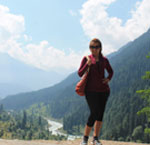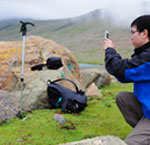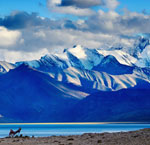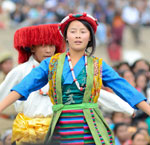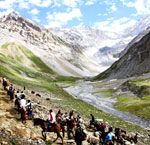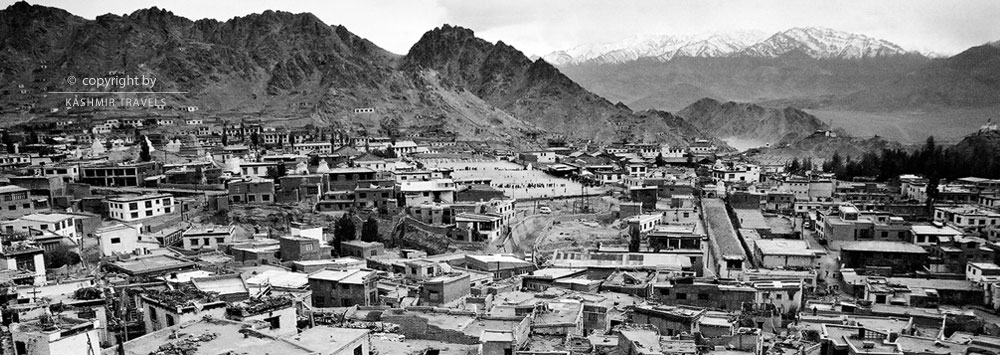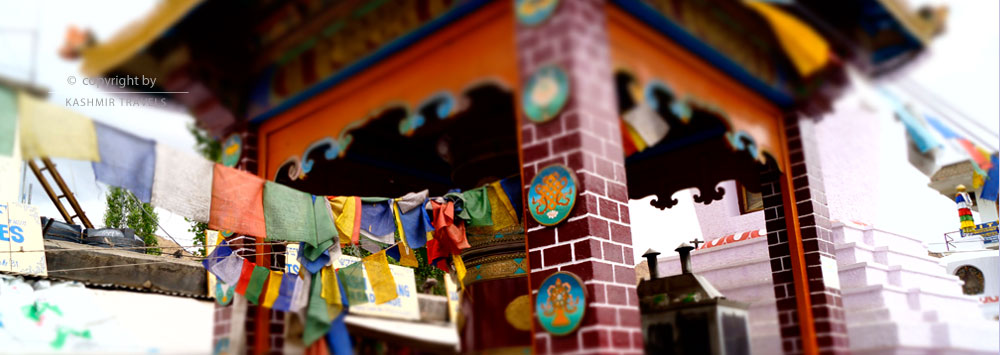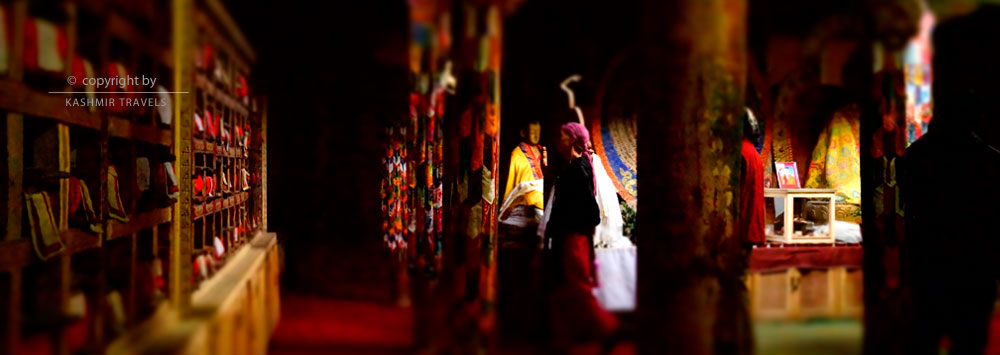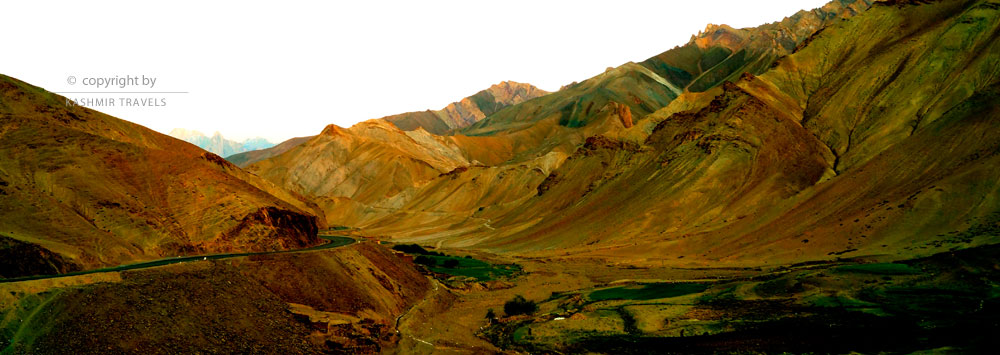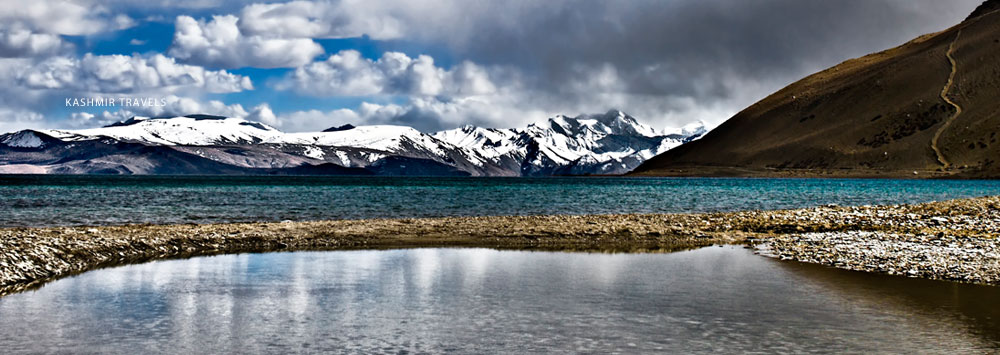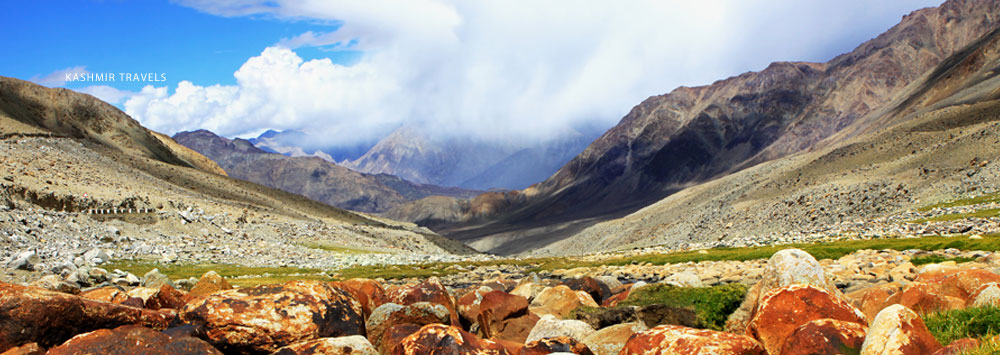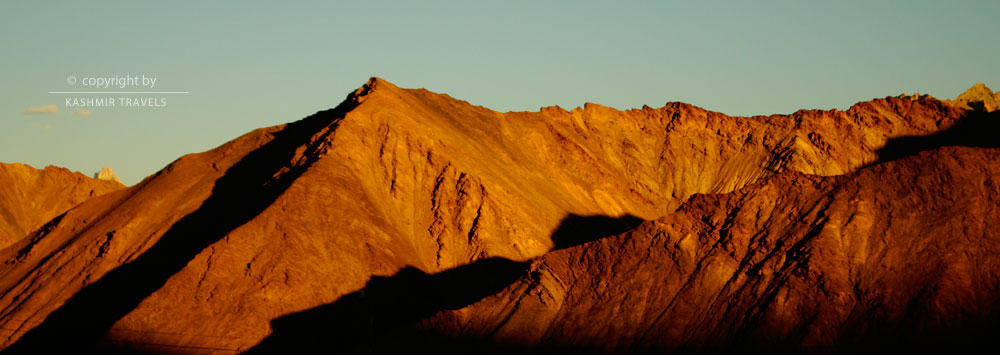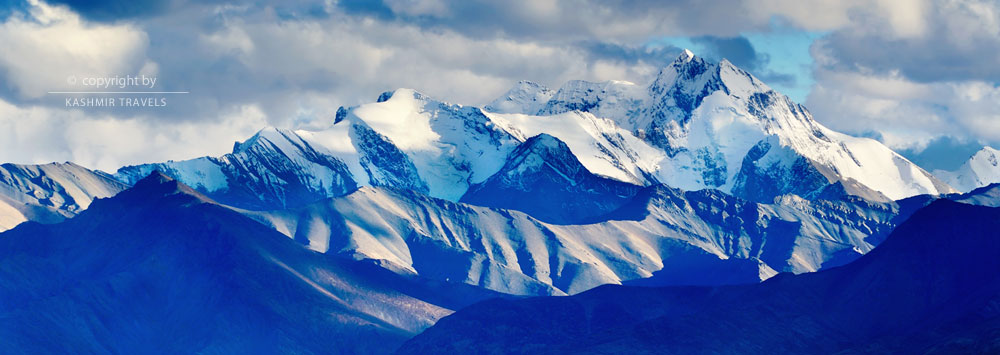LADAKH FESTIVALS
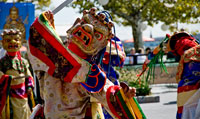 FESTIVALS OF LADAKH: A TRADITION OF FUN AND CELEBRATION
FESTIVALS OF LADAKH: A TRADITION OF FUN AND CELEBRATION
Ladakh festivities are observed with great religiosity, and the majority of fiestas include masked dances honouring the victory of virtue over evil. The celebration of the local festivals is regarded as a fundamental component of their faith.
Ladakh is richly blessed with the most picturesque views of the rolling hills, desolate terrain, and vibrant Buddhist prayer flags fluttering along the roadside. The area enjoys the best weather, with harsh winters that result in a lovely white desert and a perfect summer that allows visitors freedom of movement in milder weather.
Ladakh, also referred to as "Mini Tibet," is the centre of Buddhism in India and is home to many monasteries. These temples, which are located on top and have enormous, beautifully carved Buddha statues. The region's rich cultural legacy and the pompously observed monastery festivals of Ladakh draw tourists from around the world to enjoy these distinctive and jubilant events. Monks and priests engage in the venerated masked dances, offer prayers to the gods, and occasionally even provide sacrifices and food offerings.
The oracles, who are young monks or locals chosen to spend some time in seclusion, are a distinctive element of these monastic celebrations. Numerous sporting events also take place during this time, along with dance performances by the monks and even locals. Men's sports are organised, and they take part in them with great zeal and fervour in an effort to win the trophy. Examples include polo and archery. Dressed in brilliant colours and chunky silver jewellery, the women participate in dancing and traditional folklore music to keep the gathering lively and enjoyable. These celebrations follow the Tibetan Calendar.
The Galas are observed with vivacious fervour and excitement, demonstrating the people's deep faith in their religion. During these galas, it is also possible to see in great detail the rich cultural heritage of the province. The dates of the numerous Malas observed in the area change every year because they are all observed in accordance with the Tibetan Lunar Calendar. Galas are observed all year long. Lamas conduct mimes symbolising many aspects of the faith, such as the development of the individual soul and its purification or the victory of good over evil, while dressed in brightly coloured clothing and wearing masks.
The largest and most well-known of the monastic celebrations, attended by both tourists and locals, is Hemis, which honours PadmaSambhava and takes place in late June or the first half of July. The largest possession of the Gonpa, a massive thangka—a sacred image embroidered on clothes—is displayed once every twelve years. Summer celebrations are also held at the following monasteries: Tak-thok (early August), Phyang (late July), and Lamayuru (early July), Karsha (1 day after Phyang) in Zanskar, Thiksay, and Deskit in November. Winter festivals for Spituk, Stok, Chemrey, and Matho take place between November and March. Leh Dosmochey and the Likir Festival often take place in February. Offerings of stroma—ritual figurines made of dough—are taken out and ceremonially burned or flung into the desert at the prescribed hour. Offerings are made to the gods and goddesses both in the Gonpas and in the domestic shrines of all Ladakhi Buddhists during this festival. Ladakh's festivals, which are annually observed with tremendous fervour, are typically held in the courtyard of Buddhist monasteries.
Monks perform cham with vibrant robes and terrifying masks (sacred mask dances). These cham stand for both the triumph of good over evil and the purifying of the psyche. The birth anniversaries of religious luminaries (such as the Buddha, Padmasambhava, etc.) and other major dates in the Buddhist calendar are traditionally honoured with festivals.
The following are a few of the top 30 festivals to attend in Ladakh:
Ladakh Festival/ Ladakh Harvest Festival: Celebration of Harvest and Culture
The Ladakh Harvest Festival, a significant event held in Leh from September 1 to September 15, is organised by the Jammu and Kashmir Tourism Department. It is a vibrant celebration of the Ladakhi people's diverse cultural heritage. Week-long celebrations are held all throughout the area, and this extravaganza of ceremonial attire, deft dances, and folk music features participation from a variety of cultural troupes and communities. Additionally, you can take pleasure in the amusing polo and archery tournaments that are hosted for locals to participate in.
While there are several dance options, only men are permitted to compete in archery events and there are other events for women. Numerous cultural events are held, including polo games, folk dance performances, dancing lions and yaks, traditional music, Ladakhi cuisine, Chang (an intoxicating barley beer) and artisan exhibitions. In addition, the "Ladakh Festival Cup" polo tournament and a Central Asian trade fair are held in Leh Bazaar. One of the festival's attractions is the performance of mask dances. The tourists can take advantage of this festival to learn more about the culture and way of life of the Ladakhi people.
The Ladakh festival combines elements of the Central Asian, Tibetan, and Northern Indian civilizations that are all present in Ladakh. Local officials, schoolchildren, and dancers who perform a variety of dances to the traditional music played by the orchestra are all part of the parade. The town of Leh and the surrounding villages in Ladakh host this event.
The event comes to an end with a final carnival procession that travels through the streets of Ladakh after the monks perform the mask dance.
Festival of Losar: The Unique New Year Celebration
Two months before the Tibetan New Year, it is observed as the New Year. Losar celebration is celebrated in either December or January, the eleventh month of the Tibetan calendar. Ladakh as a whole observes it. Early in the 17th century, King Jamyang Namgyal made the decision to hold the event two months earlier than usual because he planned to launch an expedition against the Baltistan armies during the winter. Later, it developed into a custom and is now observed during the eleventh month. During these festivals, people light their homes and make sacrifices and offerings. Ibex images are hung as an auspicious emblem on the walls of kitchens, where they are thought to bring success in the upcoming year.
The Ladakhis, who have an excessive love of music, dance, and play, also include music, dramas, and masked dances into their religious ceremonies, which gives them a mystical experience. Along with the plays, there is folk dancing, accompanied by drums, cymbals, flutes, and clarinets. People go to see family and friends during the course of these two weeks of the festival. The first three days are regarded as the most significant ones. Ladakhis of all religions enthusiastically celebrate this event.
During the month-long Losar festival, deliciously prepared food is served to the Gods, other deities, ancestors, and even animals. In order to drive away ghosts and bad spirits, a parade of fire or Metho is then organised, with people singing slogans. Making snowmen, which lasts a week, is another ritual that some communities continue. This holiday is celebrated by people of all ages and family members gather together to drink tea in cups with their names written on them. Moreover, the members who are absent are not excluded from this tradition. A lot of ancient rituals are performed during this festival, including stage fights between good and evil, the Ibex deer dance.
Festival of Hemis/ Hemis Tsechu; Most popular festival honors Guru Rinpoche
The Hemis festival, a well-known Buddhist cham (masked dance) galas, honours Padmasambhava's (Guru Rinpoche),
birthday, who found Tibetan Tantric Buddhism.
The largest Buddhist monastery in Ladakh, the Hemis Gompa, holds its yearly Hemis celebration on the tenth day of the sixth month( lunar) of the Tibetan calendar.
This 3-day holiday is observed from June 9 through June 11. The Hemis Gompa or Monastery, 45 kilometres to the southeast of Leh's central city, is where it is celebrated.During this occasion, the natives don their traditional attire and perform a sacred masked dance in front of a large crowd. Males wear cummerbunds and ladies wear colourful headpieces and a lot of jewellery.
The four-storey thangka, (22 feet tall Tibetan Buddhist painting) of Guru Padmasambhava is hung in the courtyard during the monkey year, which occurs every 12 years and puts other thangkas on exhibit. The Lamas are joined by musical drums, longhorns, and cymbals as they execute the sacred masked dance known as Chaam. The various gods, goddesses, dakinis, and asuras are dramatised in the mask dance. One can see a performance by Guru Padmasambhava and his eight manifestations, which is unique to this festival.
4 . DOSMOCHE MELA: Sign of Warmer Days
The Dosmoche Festival is a yearly two-day celebration that serves as the culmination of the Tibetan New Year festivities. The Dosmoche Festival officially kicks off on the 28th and 29th day of the 12th Tibetan month, or in the middle of February. Dosmoche is frequently seen by Ladakhis as a sign of longer, warmer days following months of chilly winter days.
Dosmochey was established by the Ladakh royal dynasty as an annual event. It's the yearly prayer festival. Outside of Leh is a sizable wooden mast that has been embellished with garlands and other religious symbols. Evil spirits from the previous year's effigies(dho) are burned or thrown into the desert. At the historic temple beneath the Leh Palace, monks conduct cham, or sacred dances. It was first instituted by the royal families of Ladakh to drive out evil from their surroundings. The Takthok monastery's monks create offerings of thread crosses that are said to ward off evil and protect the location from any natural calamity. Senior monks skilled in tantric rituals create the complex thread crosses that serve as a trap for malevolent spirits, ravenous ghosts, and demonic forces.
The Dosmoche festival is also observed on the same day in Likir Gompa and Diskit Gompa in the Nubra Valley, however, the Leh Palace celebration is the biggest and most spectacular of all. The first day begins with the offering of ritual cakes (Chotpa) to the Buddhas and their entourage, which is performed by monks from various monasteries. Dosmo, a tall wooden structure that is embellished with colourful threads, is also erected. The effigy and Dosmo are both ritually burned on the second day to drive away the evil spirits.
5. MATHO NAGRANG FESTIVAL: Festival of Oracles
The Matho Nagrang Festival, a two-day occasion, is observed on the fifteenth day of the first Tibetan calendar month. The Matho Nagrang Monastery ( the sole significant building in Ladakh devoted to the Sakya school of Tibetan Buddhism ) which is located on the banks of the Indus River about 20 km south of Leh, is where it is celebrated. It is the holy monastery that belongs to the Sakya School of Tibetan Buddhism. In Ladakh, the Matho Nagrang festival and Stok Guru Tsechu are well-known as the "festival of oracles."
The oracles or 'ronstang' practise ceremonial self-mutilation and formulate prognoses for the following year. The oracles take over the bodies of two selected monks so they can make predictions for the village and people of Ladakh, unlike the event at Stok where deities take over laymen to do so. This festival features performance es by masked dancers dressed in vibrant silk brocaded robes and masks of various Gods and Goddesses.
The two oracles who attend the event in Ladakh after spending a whole month in seclusion and intense meditation are its main draw.
6. BUDDHA JAYANTI (Buddha Purnima/ Saka Dawa,/Vesak Day/ Buddha Purnima or Vesak Day):Celebrating Buddha's birth and enlightenment
Buddha's birth, enlightenment, and attainment of Nirvana (eternal release) are all commemorated on this Ladakh event. Tibetans refer to the day as the Saka Dawa, whilst the Hindu calendar refers to it as Vesak calendar, they may not always fall on the same full moon.
It is observed on the fourth day of the Tibetan calendar, which falls in June. Saka, the name of the star that is closest to the earth during the lunar month and is clearly visible, is equivalent to Dawa, the Tibetan word for "month." Saka is one of the 28 recognised main stars in Tibetan astrology calculations.
The Tarboche flagpole, which is located in the southern part of the mountain Kailash Kora, is changed annually on this day by the lamas of local monasteries. Tibetans consider it unlucky if the new pole does not stand straight after being changed.
During this occasion, individuals abstain from doing certain activities like killing animals in favour of releasing them into the wild for the day. Even lamas can be seen reciting the mantra "Om Mani Padme Hum," which is Sanskrit for "praise to the jewel in the lotus".
7. Darshan Sindhu: Honoring River Indus
A three-day celebration called Sindhu Darshan is held in June on a full moon night to honour the river Indus as an emblem of racial harmony and national unity in India. It takes place in Shey Manila, a town of around 8 kilometres, from June 1 to June 3.It is admired as a proud salute to the heroic warriors who have been fighting bravely for the safety of nation while promoting tourism in Ladakh. The most distinctive feature is that people carry water in a pot from their own state and immerse it in the Sindhu River.
A reception for all attendees is held on the opening day of the festival at Shey on the banks of the Sindhu River. The 50 senior lamas who live here also offer prayers on the banks of the rivers. Additionally, a bonfire is lit at night. A cultural programme and tour excursion are planned for the second day, which is then followed by a Puja. The third day continues to be busy with tourists due to a significant celebration that is taking place on this day.
8. Festival of Stok Guru: Forecasts for Future
The Stok Guru is an annual celebration held in Tibet that starts on the ninth and tenth day of the first month of the Tibetan calendar. The Spituk Monastery's Gurphug subsidiary, about 20 kilometres south of Leh, is where the Stok Guru Tsechu is celebrated. The Stok Guru Festival is observed throughout all of Ladakh.
The current residence of the Ladakhi Royal Family is Stok Village. In this event in Ladakh, the Buddhist monks demonstrate their fervour and faith by performing holy masked dances that mostly feature priests from the Spituk monastery. The locals of this area firmly believe the prophecies made by the oracles.
9. Festival of Yuru Kabgyat: Dance oriented Dramas featuring Padmasambhava and Yama
An annual two-day festival of joy and adoration is held at the Lamayuru monastery (around 125 kilometres from the city of Leh) also known as Yuru Gompa, in the months of July or August. It is thrown with a lot of fervour by the locals and 200 lamas living there within a monastery. It's held on days 18 and 19 of the fifth Tibetan lunar month and honours Guru Padmasambhava and the Buddhist lord of death. Additionally, Yuru monastery is located about 115 kilometres south of Leh, in the direction of Kargil, in the charming town known as "Ladakh's moonland." The Yuru Kabgyat festival in Ladakh is a fantastic chance to experience a beautiful and historic location brimming with a lively atmosphere and celebrations.The monks participate in rituals, prayers, and mask dances throughout the event.According to the holy texts, the mask dance was first performed in the eighth century to shield the populace from illnesses and natural disasters. One of the dances features Guru Rinpoche or Padmasambhava with Yama (the god of death) (also known as the Second Buddha). On the festival's last day, sacrifices are made and sacred rites are carried out.
The festival has cultural significance for participants from China, Japan, and Bhutan in addition to India.
10. TAKTHOK TSECHU: The festival of Dancing Monks
On the tenth and eleventh of the sixth month of the Tibetan lunar calendar, Takthok Tsechu is observed. A settlement called Takthok, which in Ladakhi means "Rock Roofed Cave," is situated close to Chemrey, halfway between Leh and Pangong Lake.
The sole Nyingma monastery in Ladakh, Takthok Monastery is unique of its sort and represents the earliest lineage of Tibetan Buddhism. It is the oldest of the four main schools of Tibetan Buddhism. The monastery is situated around a cave that Guru Rinpoche is thought to have utilised for meditation in the ninth century.
The Nyingma order's founder, Guru Padmasambhava, introduced the practice of monastic dance to Tibetan Buddhism. During the reign of King Trisong Detsen, he would dance to vanquish enemies and demons. The monks execute a unique Cham known as "Guru Tsengyat Cham ''—the eight manifestations of Guru Padmasambhava—during this festival. During the Takthok Tsechu festival, this monastery, which is home to about 60 monks, comes to life and celebrates an important day honouring Guru Rinpoche. The early voyages of Guru Rinpoche are portrayed in cham dances, which are sacred mask dances.
11. Phyang Tsedup: Celebrating Good over evil
The second and third days of the sixth month of the Tibetan calendar, which often falls in July or August, are when the Phyang Tsedup Festival is held. It is commemorated at the Jigten Gombo Dringumpa Monastic Dynasty's founding monastery, Phyang Monastery in Ladakh (19.1 kilometres from Leh). Jigten Gombo's thankha, which symbolises the victory of good over evil, is highly revered. However, dancing continues to be the main draw. Monks do Chham and worship their god while dressed in luxurious silk attire. The Stroma is shattered on the second day to end the procession. The carnival exhibits many of Lord Buddha's teachings.
12. THIKSEY GUSTOR FESTIVAL: Sacrifice of the 29th Day
This two-day celebration, which is held by several monasteries in Ladakh, including Thiksey, Karsha Nanzkar, and Spituk, is a significant occasion in the area. The word ‘Gustor’ in Tibetan means ‘sacrifice of the 29th day’ and the festival takes place in the famous Thiksey monastery, presided by the Gelukpa order of Buddhism, about 18 Km from Leh. The monastery also goes by the name "Mini Potala" named after the Potala Palace in Tibet, where H.H. the Dalai Lama resides.
It adheres to the Gelugpa order established in the 15th century CE by Je Tsongkhapa, On the 18th and 19th of the ninth Tibetan calendar month, the monastery holds its yearly festival known as Thiksey Gustor. The sacrificial cake (Torma) is distributed after the morning prayers, which kicks off the festivities.
A recreation of the 9th-century Buddhist monk's murder of King Lang Darma of Tibet is presented. The main attraction is the Black Hat dance (Shanak Cham).
13. Festival of Spituk Gustor: Featuring the Black Hat Dance
After Losar, Spituk Gustor is the first event celebrated in Ladakh (the New Year)On the 28th and 29th of the Tibetan lunar calendar's eleventh month, which is the winter season, Spituk Gustor is celebrated. Since the 11th century, the two-day celebration has been held at Spituk Monastery, a Tibetan Buddhist institution devoted to the Gelugpa order of Tibetan Buddhism.People go to this celebration despite the frigid weather.
The enormous thangka of Je Tsongkhapa, the sect's founder, that is on exhibit for the public is the festival's main attraction. Additionally, people line up at the main temple's gate to get blessings from protector goddesses like Mahakala and Sridevi (Palden Lhamo), whose faces are only revealed during the festival. All of the monastery holidays have as their central theme the triumph of good over evil.
The Black Hat dance, which recreates the murder of the infamous Tibetan ruler Lang Darma by a Buddhist monk named Lhalung Pelgyi Dorje in the early ninth century, is well-liked by the people. The festival continues with a series of performances featuring a Buddha, one of his well-known pupils, or a God or Goddess as the theme. It culminates with the cutting of the Torma, or cake of sacrifice, which celebrates the triumph of good over evil.
14. Festival of Shachukul Kabgyat:Featuring Cham dance by Buddha and Dharma Defenders
The most significant holiday in the Durbuk block is Shachukul Kabgyat, where participants come from numerous villages. Shachukul, or "the far-east," is a settlement that is located 125 kilometres to the east of Leh and 45 kilometres from Pangong Lake. It has been customary for monks from this block who are enrolled in educational institutions across the nation to attend this two-day event hosted at the Shachukul gompa.
The Drikung Kagyu sub-lineage of the Kagyu "oral transmission" lineage is associated with the Shachukul monastery. The Drikung Kagyu tradition's Shachukul Kabgyat, which is celebrated on the 17th and 18th days of the fifth Tibetan month, is highlighted by the Cham dance of the Buddhas and Dharma defenders, including Achi Chokyi Dolma, four-armed Mahakala, and others.
15. The Stongde Gustor festival: Featuring Sacred Mask Dance
It is a two day festival celebrated in Stongdey gompa, one of Zanskar's oldest monasteries on 28th and 29th of the 11th lunar month in the Tibetan calendar. The monastery was found by Lama Marpa, a student of Naropa, approximately 10 centuries ago. During the occasion, monks dance with sacred masks.
16. Karsha Gustor Festival: The festival of the largest yellow hat monastery
Karsha Gustor, which is observed in Zanskar's biggest monastery, Karsha Gompa, symbolises the triumph of good over evil. It is celebrated in the month of January. The Karsha Monastery, the biggest monastery in Zanskar and one that dates back to the 10th century, hosts the Karsha Gustor Festival.
The festival is well-known for the monks' mask dances, or Chamms. The ceremonies take place in the building's main courtyard. There is a space set aside exclusively for tourists, so it is a good idea to go there early and get a decent spot for yourself to enjoy the proceedings. The rites begin with trumpet blowing by monks wearing large yellow caps. Then a sheep, horse, and goat are brought in, and they are worshipped. Subsequently the masked dances start.
Another ceremony involves the blessing of newlywed couples with a sacred cloth called the Kata by the monks and locals.
17. Festival de Korzok Gustor:Honoring Dharampalas,guardian divinities of Buddhist pantheon
The Korzok Gustor festival is one of the most spectacular and stunning celebrations in the entire Ladakh region, with the Korzok monastery facing the magnificent Tso Moriri lake. At a height of 4,530 metres, in the Changthang area, the Korzok monastery is situated on the coast of Lake Tso Moriri. The celebration is held on the third and fourth days of the sixth Tibetan calendar month. The presence of Changpa nomadic clans of the Changthang plateau( towering above the rest of India in the eastern part of Ladakh) living in Korzok hamlet attend the festival in huge numbers and lend charm to the event.
Kunga Lodro Ningpo created the Korzok monastery, which belongs to the Drukpa lineage, some three centuries ago. Black Hat dance, a tradition during every Gustor celebration, is performed to commemorate the execution of Buddhist monk Lang Dharma, an apostate king. This festival is the place to go if you want to learn more about the traditional pastoralist way of life of nomads.
18. Shey Doo Lhoo: Commemorating the sowing season
Shey Doo Lhoo, which commemorates the beginning of the sowing season, is observed at Shey monastery on the 29th and 30th of the first month of the Tibetan lunar calendar. Villagers prepare meals while congregating at the Shey palace for the celebration. The locals are blessed and prayed for by the monks of the Hemis monastery. They have an oracle as well. According to tradition, there are seven brothers who serve as oracles and are located throughout several Ladakhi monasteries.
19. Celebration of Sani Naro Nasjal: Festival of receiving blessings
Sani Monastery was founded during the Kanishka Empire in the first century CE. Sani is therefore the oldest monastery in the Ladakh region and Valley of Zanskar. Currently, it is a part of the Drugpa Kagyu sub-lineage of the Kagyu School. Sani Naro Nasjal, the monastery's yearly festival, is held between the 15th and 20th of the sixth Tibetan month. Sani hosts performances by the Bardan monastery monks.
For the occasion, a statue of renowned Yogi Naropa is revealed in order to bless the villagers and pilgrims. It's interesting to note that only Sani, out of all the monastic celebrations, features dances from the village's newlywed wives. The locals greet, congratulate, and wish the newlyweds with auspicious khattaks at the conclusion of the festivities (traditional ceremonial scarves). You could also see the famous Kanishka Stupa behind the Sani Monastery blooming and the Guru Naropa flower in full bloom.
20. Festival of Diskit Gustor: Burning Stromas
The Diskit Gustor festival is celebrated in October by the citizens of Diskit, the Nubra Valley's administrative centre. The tallest statue of future Buddha, known as Maitreya, is placed at Diskit monastery. The famed Diskit Gustor annual celebration takes place on the 28th and 29th of the ninth month of the Tibetan lunar calendar. People from practically every village participate in it in great numbers because it is one of the major celebrations in the entire Nubra region. Like other Ladakh celebrations, the demonic effigy (known in Ladakhi as Stroma) is burned, symbolising the triumph of good over evil.
Throughout the two-day event, the Diskit Gompa monks perform cham. The Gelug lineage is connected to the monastery.
21. Festival of Chemrey Wangchok: Dedicated to Drugpa order of Tibetian Buddhism
One of Ladakh's most gorgeous monasteries is the hilltop Chemrey Gompa. Even though the monastery is well-known, not many people are aware of the Chemrey Wangchok festival that is held there each year. This monastery dates back to the fifteenth century. On the 28th and 29th days of the ninth Tibetan lunar month, this event is observed. Following a week of meditation, Drukpa lineage monks conduct cham on both festival days.
The Chemrey monastery was established in 1664 as a memorial to the great king Sengge Namgyal by Lama Tagsang Ragspa, the pontiff of the king. The son and wife of Sengge Namgyal, King Deldan Namgyal and Queen Mother Skalzang Dolma, supported it. A two-storey statue of Guru Padmasambhava can be found in the monastery.
22. Festival of Galdan Namchot: Ushering New Year Festivities and honouring Je's Buddhahood.
The Galdan Namchot festival ushers in the Ladakh New Year festivities. The purpose of this celebration is to honour Je's birth and Buddhahood. The Gelugpa sect was started by the Tibetan scholar Tsongkhapa. During Galdan Namchot, all the monasteries, governmental structures, and residences are illuminated. Butter lamps are prepared and lit to symbolise the triumph of light over darkness. Throughout the celebration, they create mouth-watering treats and visit their loved ones to share meals.
23. Polo Festival in Ladakh: The heritage game
Polo Festival of Ladakh is one of the celebrations that is all about thrill and excitement. It is a heritage game that celebrates the local way of life and is accompanied by music, dance, and other festivities. It usually takes place in the month of July.
The game of polo is thought to have been introduced to Ladakh in the 15th century CE by a Balti princess who also happened to be the mother of the Ladakhi king, Sengge Namgyal.
The game has gained popularity through time and is now viewed as being an integral component of Ladakhi culture. This game, which the populace adores, is played throughout regional sporting events as well as all holiday celebrations including Losar (the Buddhist New Year) and Nowruz (Muslim New Year). But it's interesting to notice that Ladakh's version of polo is distinct from that played elsewhere in the world. The game is played on parched soil here, which makes it considerably more difficult and competitive than it is elsewhere. Every goal scored by a player is accompanied by traditional folk instruments like "daman" and "surna," which are played by each team's six players. Along with the well-known local play Abi-Apo (grandmother-grandfather), archery competitions are also held there.
Ladakh's distinct culinary traditions are represented in its most well-known dishes, including kholak, chutai-sku (local pasta), mok mok (dim sum), and tukpa (soup noodles) (barley). The Ladakhi handicrafts on display during this event are a key draw as well. You can find a variety of handicrafts at the numerous stalls, including pattu (a rough woollen cloth), baskets, Thangka paintings, pashmina shawls, and hand prayer wheels, among other things.
24. ARCHERY FESTIVAL OF LADAKH: A part of its tradition
Ladakh's traditional game of archery is regarded as being a part of its culture and tradition. This is a summertime sport that is performed with a lot of passion and zeal on open fields. It was formerly known in Turtuk as "Penmazkyukpa," which means "s hooting" in English. The majority of Ladakh's archery events take place in the summer.In addition to archery, there is a lot of dancing, drinking Chang, the local barley beer, and listening to music. In the past, Leh's Arghon Dar-Tses was one of the most well-known archery festivals.
It is also related to the religion Qasida and Salawat in Kargil.
25. Yargon Tungshak: The winter festival featuring Cham Dance
One of the most popular events in Nubra Valley is Yargon Tungshak, which is celebrated with a lot of fanfare and spectacle. This two-day celebration is a winter festival in Ladakh. It takes place in the month of February or early March in the Nubra Valley. Yargon Tungshak's main draw is a presentation of the ancient Cham dance, often known as the mask dance.. During the celebrations, a feast is prepared and a variety of Ladakhi cuisines, including skyu and thukpa, are enjoyed.
26. Gang-Sngon Tsedup Festival: Festival of Sacred Dance
Every year, from the 17th to the 19th day of the first month of the Tibetan calendar, the Gang-Sngon Tsedup Festival is held. Phyang serves as a location for sacred dances on the second and third days of the sixth month of the Tibetan calendar.
27. H.H. Birthday of The Dalai Lama:
The Wood-Pig Year, Fifth Month, Fifth Day of the Tibetan Calendar, or July 6, 1935, marks the birth of the 14th Dalai Lama. He is the current Dalai Lama, Tibet's most revered spiritual and former political leader, and is better known to Tibetans as Gyalwa Rinpoche.
28.The Tukpey Cho-Nga Tserkarmo Monastery Festival: Commemorating death anniversary of Lord Gampo La
It is being celebrated every year on the full moon day of the 6th Tibetan calendar in Tingmosgang. This festival is celebrated to commemorate the Maha Parinirvana (death anniversary) of the Kagyud Master Lord Gampo pa.
A week-long special Achi Choskyi Drolma (Kangdos) prayer and rituals are conducted by the llamas for world peace and prosperity. At the end of the ritual ceremony sacred tantric mask dances are performed followed by a colourful cultural program at Tserkarmo Monastery. Devotees from all parts of Ladakh and foreign tourists take part in this festival.
29.Yargon Tungshak Festival of Ladakh: Festival of Nubra Valley
Celebrated with a lot of pomp and show, Yargon Tungshak Festival is one of the top festivals in Nubra Valley. This two-day festival is held in the month of February, and thus it is a winter festival in Ladakh. The main attraction of Yargon Tungshak is the performance of the traditional Cham Dance or Mask Dance. Feast is prepared and a variety of traditional dishes of Ladakh like skyu and thukpa are savoured during the celebrations.
30. Nyoma Gustor: Festival of World Peace
Annual festival celebrations known as Nyoma gustor take place in Nyoma Changthang (ladakh). Gustor, which translates to "Sacrifice of the 29th Day" in the local Ladakhi language, is a traditional ritual held in monasteries on the 27th, 28th, and 29th days of the 8th month of the Tibetan calendar and represents the triumph of good over evil. This festival's primary goals are world peace, happiness, and the wellbeing of all living things.
FAQ's
1.Which Ladakhi festival is significant or important?
The Saka Dawa Festival is Ladakh's most significant festival. It is regarded as the most sacred Buddhist holiday in this location.
2.For how many days does the Ladakh harvest festival last?
Every year between the first and fifteenth of September, the Ladakh Harvest Festival is observed. In Leh, a procession of cultural groups enters Leh Market to kick off the celebration. People dress in colourful traditional garb, and there are numerous musical and dance acts.
3.Which holiday is observed by the Ladakhi people on the first day of the year?
Festival Of Losar In Ladakh. The masked dance stands out among the other performances that take place on the third day of the festival. The first three days are when the biggest festivities occur.
4.Which is the popular festival of Ladakh?
One of the must-visit events in Ladakh is Hemis Tsechu. It is a vibrant two-day event that takes place on the tenth day of the fifth Tibetan lunar month. The event honours Guru Padmasambhava, the founder of the Nyingma order of Tibetan Buddhism, on the occasion of his birth anniversary.
5.Which celebration does the Ladakh government organise?
Every year, the Department of Tourism sponsors the seven-day Ladakh Festival to promote travel. The primary goals of holding this event in September are to promote and showcase the region's rich cultural history and to lengthen the region's short tourism season.
6.How many festivals are celebrated in Ladakh?
Ladakh celebrates numerous festivals including the Saka Dawa Festival ,Hemis Festival, Harvest Festival, Losar Festival and Dosmoche Festival.
Refer to " Festivals of Ladakh" for further info.
7.How many different kinds of harvest festivals exist in India?
Makar Sankranti, Baisakhi, the Ladakh Harvest Festival, Lohri, Bhogali Bihu, Basant Panchami, Wangala, Ka Pomblang Nongkrem, Pongal, Nuakhai, Gudi Padwa, Nabanna, and Onam are the 13 most well-known harvest festivals in India.
8.What is the Ladakhi folk dance?
The khatok chenmo, cham, and other dances are common in Ladakh.
9.Which Ladakh monastic celebration is the largest and most well-known?
Hemis festival, one of Ladakh's most well-known monastery celebrations, is held in June to honour the founding father of Tibetan Buddhism, Guru Padmasambhava.
10.How many Hindu temples are there in Ladakh?
One can find six temples, including Sumstek, Lotsawa Lhakhang, Manjushree Lhakhang, Vairocana temple, Kangyur temple, and Lhakhang Soma.
11.How is the Ladakh Harvest Festival celebrated?
In Leh, a procession of cultural groups enters Leh Market to kick off the celebration. People dress in colourful traditional garb, and there are numerous musical and dance acts. Archery and polo are some of the additional events at the celebration.
12.What do the people of Ladakh traditionally wear?
Both sexes in Ladakh wear the Goncha, Kos, or Sulma as their primary clothing, which is accessorised with a vibrant sash knotted around the waist. The women's robe, however, has a downward flair and is accented by tiny pleats to create flowy garments.
13.What religions are practised in Ladakh?
Muslims (mostly Shia) make up 46% of the population, followed by Buddhists (primarily Tibetan Buddhists) 40%, Hindus (12%), and others (2%).
14.Why is Ladakh popular?
Travellers love Ladakh for its spectacular scenery, crystal-clear skies, highest mountain passes in the world, thrilling adventure activities, serene Buddhist monasteries, vibrant handicrafts, rich culture, and several festivals that are held there.
15.What is Ladakh's cuisine?
The primary foods consumed by the Ladakhi people are Sku and Thukpa (made from wheat flour), Pava (made from sattu), and Khambir (local Ladakhi bread). To adapt to the chilly environment, the locals also eat a lot of meat (mutton and poultry).
16.Which language is spoken in Ladakh?
The Ladakhi language's official form is Bhoti (or Bodhi). It is primarily a Tibetic tongue that is commonly used in India's Ladakh region. Tourists won't have any trouble communicating in this area because English is also commonly spoken here.
17. Why is Hemis festival of Ladakh popular?
On this well-known event in Ladakh, the Hemis Monastery hosts performances of the Cham Dance and other traditional dances to the sounds of drums, cymbals, and Tibetan musical instruments that resemble long pipes. Huge thangkas (Buddhist paintings) are unfurled for the public on both days. Chaang drink is also consumed.

